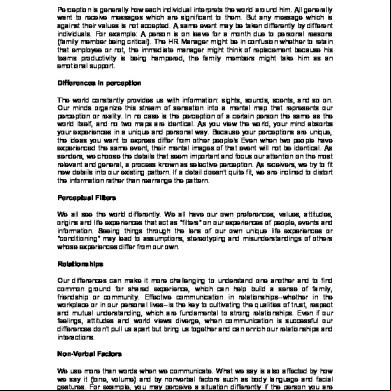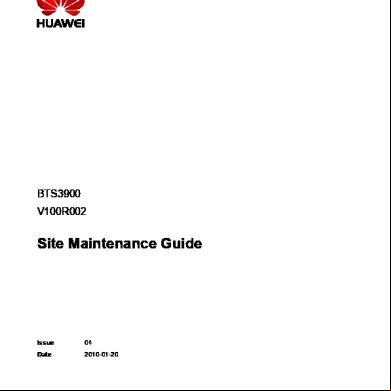Perceptual And Language Differences c4g58
This document was ed by and they confirmed that they have the permission to share it. If you are author or own the copyright of this book, please report to us by using this report form. Report 3zb22
Overview 124f1p
& View Perceptual And Language Differences as PDF for free.
More details 2x4n45
- Words: 663
- Pages: 2
Perceptual Communication Barrier Perception is generally how each individual interprets the world around him. All generally want to receive messages which are significant to them. But any message which is against their values is not accepted. A same event may be taken differently by different individuals. For example: A person is on leave for a month due to personal reasons (family member being critical). The HR Manager might be in confusion whether to retain that employee or not, the immediate manager might think of replacement because his teams productivity is being hampered, the family might take him as an emotional . Differences in perception The world constantly provides us with information: sights, sounds, scents, and so on. Our minds organize this stream of sensation into a mental map that represents our perception or reality. In no case is the perception of a certain person the same as the world itself, and no two maps are identical. As you view the world, your mind absorbs your experiences in a unique and personal way. Because your perceptions are unique, the ideas you want to express differ from other people's Even when two people have experienced the same event, their mental images of that event will not be identical. As senders, we choose the details that seem important and focus our attention on the most relevant and general, a process known as selective perception. As receivers, we try to fit new details into our existing pattern. If a detail doesn't quite fit, we are inclined to distort the information rather than rearrange the pattern. Perceptual Filters We all see the world differently. We all have our own preferences, values, attitudes, origins and life experiences that act as "filters" on our experiences of people, events and information. Seeing things through the lens of our own unique life experiences or "conditioning" may lead to assumptions, stereotyping and misunderstandings of others whose experiences differ from our own. Relationships Our differences can make it more challenging to understand one another and to find common ground for shared experience, which can help build a sense of family, friendship or community. Effective communication in relationships--whether in the workplace or in our personal lives--is the key to cultivating the qualities of trust, respect and mutual understanding, which are fundamental to strong relationships. Even if our feelings, attitudes and world views diverge, when communication is successful our differences don't pull us apart but bring us together and can enrich our relationships and interactions. Non-Verbal Factors We use more than words when we communicate. What we say is also affected by how we say it (tone, volume) and by nonverbal factors such as body language and facial gestures. For example, you may perceive a situation differently if the person you are speaking with is smiling or frowning, has body odor and is standing too close or is not
giving you direct eye . In turn, this individual is simultaneously assessing your verbal and nonverbal cues. A negative "read" can often trigger unproductive or dysfunctional emotional responses, such as anger or oversensitivity, thus affecting the flow and outcome of communication. Roadblocks to Success People who can't get past perceptual barriers to communication are likely to experience roadblocks in both their professional and personal lives. Misunderstandings result when parties are not willing to see past differences or take the time to understand each other's perspectives. Ignorance, judgments, stereotypes and misunderstanding cannot be the basis for business or intimacy. Overcoming perceptual communication barrier If we choose to communicate consciously, then our differences don't have to become roadblocks. In fact, they can enrich our interactions tremendously. Start by listening to others, clarify if there is confusion, stay calm and be positive. An attitude of good will and tolerance toward others goes a long way--even if you miscommunicate or do not like another's words or actions, you are more likely to default to a response that is nonharming, making it easier to appreciate and learn from one another.
http://www.ehow.com/list_6756817_perceptual-barriers-communication.html
giving you direct eye . In turn, this individual is simultaneously assessing your verbal and nonverbal cues. A negative "read" can often trigger unproductive or dysfunctional emotional responses, such as anger or oversensitivity, thus affecting the flow and outcome of communication. Roadblocks to Success People who can't get past perceptual barriers to communication are likely to experience roadblocks in both their professional and personal lives. Misunderstandings result when parties are not willing to see past differences or take the time to understand each other's perspectives. Ignorance, judgments, stereotypes and misunderstanding cannot be the basis for business or intimacy. Overcoming perceptual communication barrier If we choose to communicate consciously, then our differences don't have to become roadblocks. In fact, they can enrich our interactions tremendously. Start by listening to others, clarify if there is confusion, stay calm and be positive. An attitude of good will and tolerance toward others goes a long way--even if you miscommunicate or do not like another's words or actions, you are more likely to default to a response that is nonharming, making it easier to appreciate and learn from one another.
http://www.ehow.com/list_6756817_perceptual-barriers-communication.html










